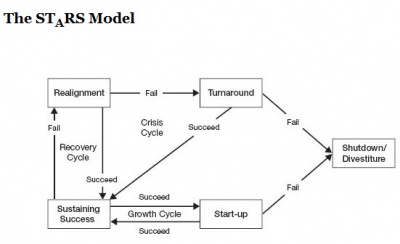90 Days - Part 3: Match Strategy to Situation
Summary

While effective learning reduces the window of vulnerability associated with the initial 90-day plan, learning translates quickly into strategy. Leveraging the STaRS model allows you to translate learnings into strategy, effectively matching the business situation.
STaRS Model
STaRS defines most business situations as falling into one of the following for categories:
- Start-Up
- Turnaround
- Realignment
- Sustaining Success
Start-ups involve creating capabilities to get something new off the ground; whether it be a new business, product, project, or piece of your organization. Turnarounds involve placing something identified as being off track and in trouble, and addressing what is needed to get it back aligned. Both start-ups and turnarounds are usually very visible and require intensive work - with decisions made rapidly.
Realignments involve organizations, processes or projects that are either headed in the wrong direction, or are not delivering against expectations, thus require us to re-think, re-invent, re-envision to drive results to a new level. Sustaining Success situations are just that - successful, and requiring management to continue down this path, likely looking at strategies to both ensure continued success, but also likely to take results to a new level as well.
Business units, products or projects cycle through as diagrammed to the right. In starting at a realignment with a business unit, actions which lead to failure may result in the strategy shifting into a turnaround. If a realignment effort succeeds, you shift into a sustaining success mode, and adjust your strategy accordingly.
Identifying the area that your initiative falls into, and understanding the uncharacteristic associated with achieving success will help in reaching the common goal - growing a successful business.
Aligning Skills to STaRS Model

STaRS model - aware of the management skills necessary for success in the different modes of the STaRS model:
- Start-Ups and Turnarounds: Hunters, people who move fast, can make independent rapid decisions on the business situation.
- Realignment and Sustaining Success: Farmers, more subtle skills that focus on understanding culture and politics of the organization, promoting strong collaboration, shared thinking, bench marking, etc.
- Ready aim fire(RAF) vs. Ready fire aim(RFA)
Correct diagnosis of energy behind each model:
- Emphasis on Learning vs. Doing
- Turnarounds & Startups: Doing (learning still critical, but fast action (RFA)
- Realignments and Sustaining Success: Learning, educating then doing.
- Offense vs. Defense
- Turnarounds & Startups: Offense
- Realignments and Sustaining Success: Defense
- What is required in each to deliver early wins
- Align what a WIN means relative to each category - what you are going to do as well as NOT going to do
Diagnosing Portfolio
- Post learning - assign pieces (products, processes, projects, people) to STaRS categories
- Rewarding Success within framework
Notes
- ↑ Watkins, Michael (2003-11-06). The First 90 Days: Critical Success Strategies for New Leaders at All Levels (p. 64). Perseus Books Group. Kindle Edition.
- ↑ Watkins, Michael (2003-11-06). The First 90 Days: Critical Success Strategies for New Leaders at All Levels (p. 64). Perseus Books Group. Kindle Edition.